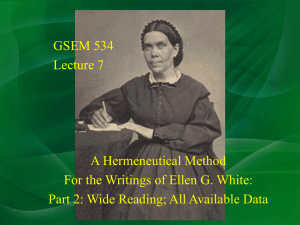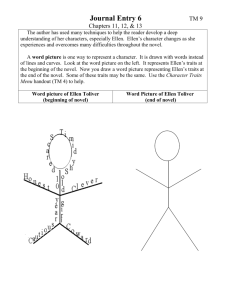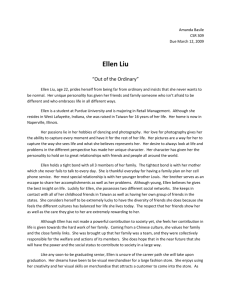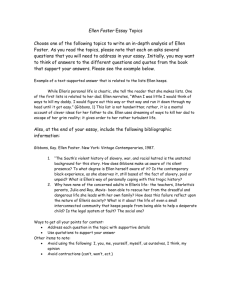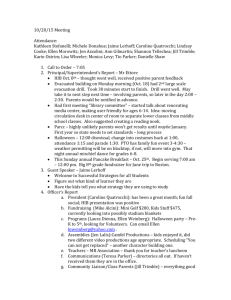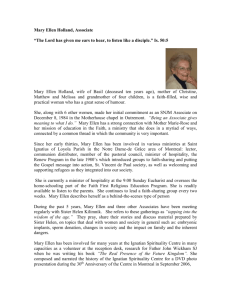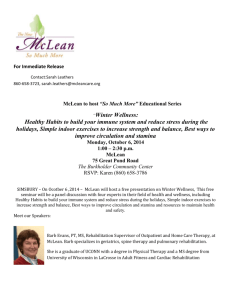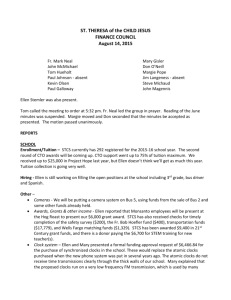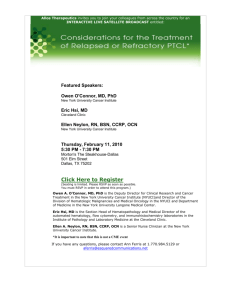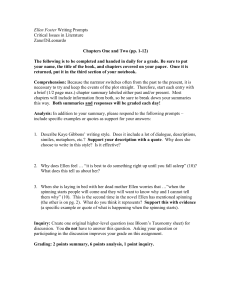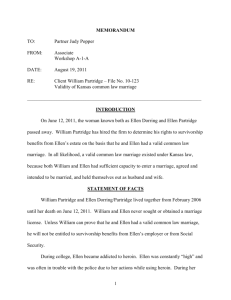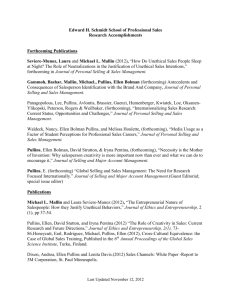books-i-am-reading - Ellen Swallow Richards
advertisement
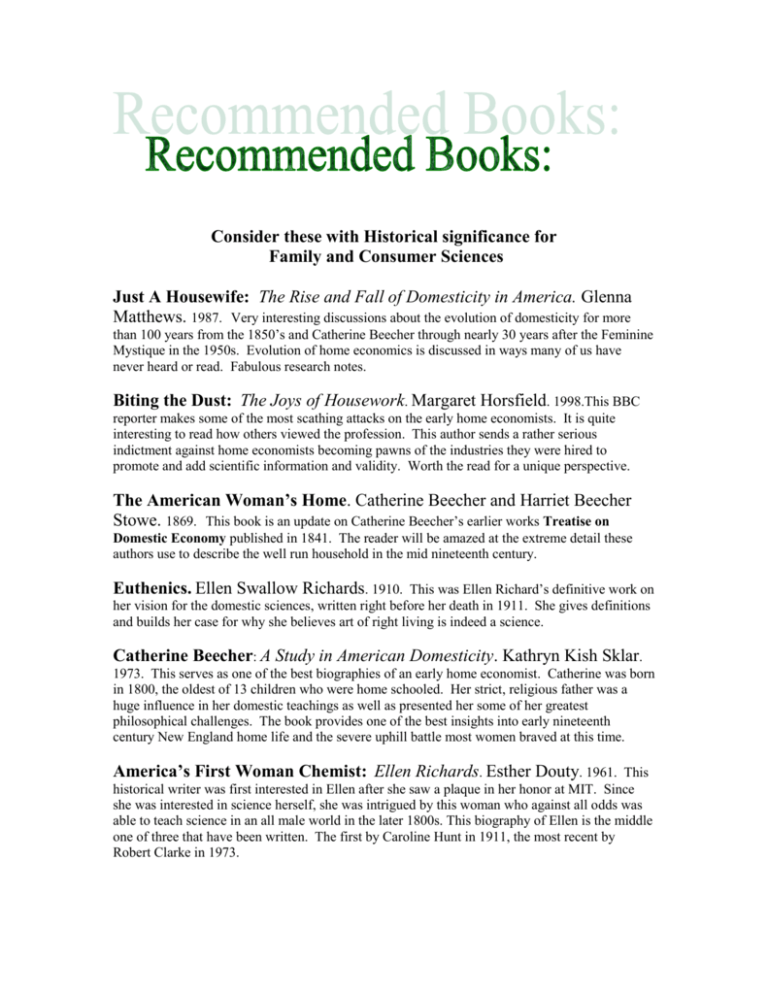
Consider these with Historical significance for Family and Consumer Sciences Just A Housewife: The Rise and Fall of Domesticity in America. Glenna Matthews. 1987. Very interesting discussions about the evolution of domesticity for more than 100 years from the 1850’s and Catherine Beecher through nearly 30 years after the Feminine Mystique in the 1950s. Evolution of home economics is discussed in ways many of us have never heard or read. Fabulous research notes. Biting the Dust: The Joys of Housework. Margaret Horsfield. 1998.This BBC reporter makes some of the most scathing attacks on the early home economists. It is quite interesting to read how others viewed the profession. This author sends a rather serious indictment against home economists becoming pawns of the industries they were hired to promote and add scientific information and validity. Worth the read for a unique perspective. The American Woman’s Home. Catherine Beecher and Harriet Beecher Stowe. 1869. This book is an update on Catherine Beecher’s earlier works Treatise on Domestic Economy published in 1841. The reader will be amazed at the extreme detail these authors use to describe the well run household in the mid nineteenth century. This was Ellen Richard’s definitive work on her vision for the domestic sciences, written right before her death in 1911. She gives definitions and builds her case for why she believes art of right living is indeed a science. Euthenics. Ellen Swallow Richards. 1910. Catherine Beecher: A Study in American Domesticity. Kathryn Kish Sklar. 1973. This serves as one of the best biographies of an early home economist. Catherine was born in 1800, the oldest of 13 children who were home schooled. Her strict, religious father was a huge influence in her domestic teachings as well as presented her some of her greatest philosophical challenges. The book provides one of the best insights into early nineteenth century New England home life and the severe uphill battle most women braved at this time. America’s First Woman Chemist: Ellen Richards. Esther Douty. 1961. This historical writer was first interested in Ellen after she saw a plaque in her honor at MIT. Since she was interested in science herself, she was intrigued by this woman who against all odds was able to teach science in an all male world in the later 1800s. This biography of Ellen is the middle one of three that have been written. The first by Caroline Hunt in 1911, the most recent by Robert Clarke in 1973. Beatrice Paolucci: Shaping Destiny Through Everyday Life. Margaret Bubolz. 2002. This is a wonderful story of one of the true professionals in our century and was actually written by a committee of Bea’s contemporaries. For those of us who never had the opportunity to meet Bea or to engage in any dialogue, this is an intimate look at the person who probably did more for defining the profession than any other person. We all have read and discussed the famous Brown and Paolucci work, but this is the first insight I ever had about the person of Bea Paolucci. The multiple approach of the authors reflects her roles as a devoted and generous family member, daughter, sister, sister-in-law, aunt, loving and compassionate friend, superb teacher, provocative thinker and voracious reader. Another must read for the new professional. Revolution at the Table: The Transformation of the American Diet. Harvey Levenstein. 2003. The author proposes that America changed its diet over a period of about 50 years from 1880-1930. His work attempts to analyze the economic, social, ideological forces, the complex interplay among networks of reformers, scientists, industrialists, faddists and hucksters which brought about this change. The birth of home economics finds itself right in the middle of this discussion. A discussion of the New England Kitchen enjoys an entire chapter. This is also a must read for anyone who is trying to place the birth of our discipline in the proper national context. Hidden From History: The Lives of Eight American Women Scientists. Kim K. Zach 2002. There is little in this book that we don’t already know about Ellen Richards. However, it is the intent of the author where we need to take notice. She arrives at the eight women in her book after visiting the Seneca Falls Women’s Hall of Fame and realizing that she really doesn’t recognize but a very few of the women scientists who are honored here. Most are just “accidental scraps” as suggested by Walt Whitman. Each woman in this book faced huge challenges and still persevered. These are their stories and Ellen’s is among them. Others of Interest for various reasons: Maria Mitchell: The Soul of an Astronomer, Beatrice Gormley. 1995. Captivating and energizing story of the woman who ignited Ellen Swallow’s desire to seek the sciences as her life’s work. From childhood memories to the American Academy of Arts and Sciences, we follow the remarkable career of one of the first women of science. Endless Crusade: Women Social Scientists and Progressive Reform, Ellen Fitzpatrick. 1990. Engrossing story about four women whose lives intersected in efforts to bring social issues and reform to the forefront in the Progressive Era. Edith Abbot, Sophonisba Breckenridge, Katharine Bement Davis and Frances Kellor. Made From Scratch: Reclaiming the Pleasures of the American Hearth. Jean Zimmerman. 2003. Award winning journalist Zimmerman traces the history of domesticity and relates historical memories she has of her grandmother’s day. She relates much of her home economics knowledge as coming from a great aunt who was a teacher of the subject. Her discussions of the challenges today balancing work and maintaining family traditions should interest many in our profession. Girl Sleuth: Nancy Drew and the Women Who Created Her. Melanie Rehak. 2005. Since I was an avid Nancy Drew fan in my teen years, I wondered how this possibly related to our profession. The author builds the story of the two women who wrote the Nancy Drew books under the pen name of Carolyn Keene. These two women were modern pioneers way ahead of their time with their own stories that detail women’s progress as well as their challenges early in the twentieth century. There is reference to both Ellen Richards as well as to her husband Robert. A Fierce Discontent: The Rise and Fall of the Progressive Movement in America 1870-1920. Michael Mc Gerr. 2003. For the serious history buff, this author assists us to accurately position the home economics movement in the mix of all that was happening on either side of the turn of the century. This selection provides us with names of many of the other reformers who most likely knew Ellen Richards, if not personally at least by reputation. Reading about the country during this time lends a certain quality of authenticism to the struggles that we know Ellen faced during the same time period. The author’s research notes are invaluable for the scholar who wants to delve more into the time period. The Devil in the White City: Murder, Magic, and Madness at the Fair that Changed America. Erik Larson. 2003. The author is quite successful in telling the story of two men and their involvement with the 1893 World’s Fair-the brilliant architect who designed the legendary Fair and a cunning killer who used the Fair to lure victims to their death. While the actual book is fiction, the accounts of Chicago at the turn of the century are accurate as is the story of the killer on the midway. This is just one more opportunity for the reader to immerse themselves in the culture at the turn of the century.
